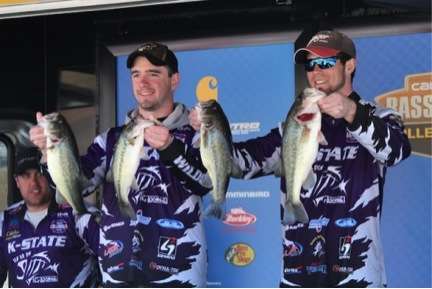
This event was one of five regional tournaments for the Carhartt Bassmaster College Series. After a long winter of anticipation — studying old fishing reports, tournament results, weather patterns and the lake’s topographic features with the Navionics phone app — my partner Graham Howard and I were ready to hit the lake. We were so excited to finally be out on the water doing what we love and getting the opportunity to qualify for the national championship.
While everyone was at the beach having a good time on spring break, we were at the Ozarks for a couple days pre-fishing. After preparing all winter I already had a plan in mind. When we got down there, the water was still in the low 40’s and I was hoping it would be warming up over the next week. In the colder water, however, we used my Lowrance electronics to find fish staging out on main creek arm points and ends of channel swings in the Grand Glaize Creek Arm. I was slow rolling an A-rig or dragging a Jewel finesse jig and Graham was throwing a Wiggle Wart and jerkbait. This seemed to be working for us as we caught, what would have been a 17-pound bag, the first day we were there. Leaving the lake feeling confident in our findings, we decided that one more practice day, the day before the tournament, was all we needed to refine our strategy.
After a short and stressful week of completing assignments before we could leave, we made it down to the lake around 11 p.m. Wednesday. Running on a few hours of sleep, adrenaline and some powdered sugar donuts, we hit the lake early looking for those bass from the week before. The water had warmed slightly into the 47 to 50 degree range, and the fish were supposedly more active and moving back into the creeks. Despite all the good fishing reports, we seemed to struggle in practice. The only fish we caught that day was a 5-pounder on a point where the channel swings up against the bank. After that, we knew this would be our starting spot on Day 1. I was nervous because we only had a couple spots to work with, but I kept a positive attitude.
As Day 1 of the tournament rolled around, we were boat number 64 to launch out of 75. Afraid someone would beat us to our spot, the 6-mile run was nerve racking. Unfortunately, it didn’t matter because out of the three times we fished it that day, neither of us got a single bite.
Trying similar things throughout the morning and evolving into new techniques and areas in the afternoon, we finally got ahold of some short fish. Using the information those short fish gave us, we hit a spot on the way back to the weigh in that appeared to be good. Thankfully, Graham caught our only keeper of the day, a 4-pounder, with five minutes to spare before heading back.
Sitting in 36th place, we were ready to get after it on Day 2. I knew we had something going at the end of Day 1, but there just wasn’t enough time to pursue it. Starting in the same spot Graham caught the 4-pounder, our hopes were high that it could produce again. Graham caught a solid keeper on his third cast, and I caught one over 3 pounds with my Jewel jig on our second pass. After fishing the spot for a few hours waiting for the fish to move up, we left to find some new water. Purely on instinct, we drove around looking for the right banks along with some help from my Lowrance fishfinders and Navionics chip. The rest of the day was slow. We caught a bunch of short fish, and I caught two more 3-plus-pounders on that trusty Jewel jig. We never got hold of that fifth keeper and I knew it would take a miracle to qualify us.
Fortunately that 12-5 bag on Day 2 gave us 16-5, which was enough to move us up into the 13th spot and qualify for the national championship later this year.
Garrett Cates is a college angler from Kansas State University.
